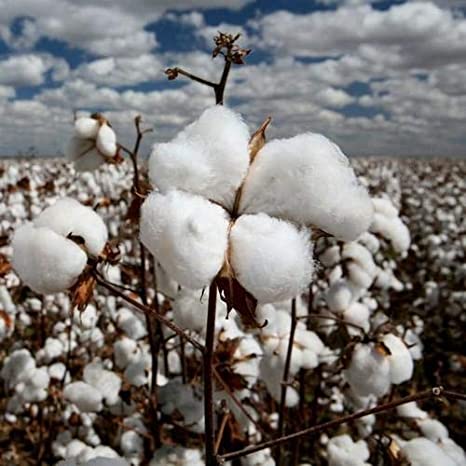
Cotton plant
- Cotton is a soft, fluffy staple fiber that grows in a boll, or protective case, around the seeds of the cotton plants of the genus Gossypium in the mallow family Malvaceae.
- The fiber is almost pure cellulose, and can contain minor percentages of waxes, fats, pectins, and water.
- Under natural conditions, the cotton bolls will increase the dispersal of the seeds.
- The plant is a shrub native to tropical and subtropical regions around the world, including the Americas, Africa, Egypt and India. The greatest diversity of wild cotton species is found in Mexico, followed by Australia and Africa.Cotton was independently domesticated in the Old and New Worlds.
USES:-
- Textiles: Cotton fibers are used to make soft, comfortable and absorbent textile products like clothing, bed sheets, towels, etc.
- Medical products: The highly absorbent and sterilizable cotton fibers are used in medical products like bandages, gauze, and swabs.
- Paper products: Cotton is used to make high-quality paper products like currency paper due to its strength and durability.
- Cooking oil: Cottonseed oil, extracted from cotton seeds, is used as a neutral-flavored cooking oil due to its high smoke point.
- Animal feed: Cottonseed meal, a byproduct of cotton processing, is used as a protein-rich animal feed supplement.
- Industrial products: Cotton fibers are used in industrial products like ropes, twine, and insulation, while cottonseed oil is used in soap and cosmetic production.
Cultural & Historical Importance:
- Cultural importance: Cotton has played a significant role in many cultures throughout history, particularly in the United States, where it was a major cash crop and a symbol of the country's economic and social development.
- Historical importance: The cotton industry played a major role in the development of the global economy, particularly during the Industrial Revolution, when cotton textiles became a key driver of economic growth and international trade.
Plantation:-
- Watering
Cotton plants require consistent and adequate watering throughout their growth cycle to produce healthy and high-quality fibers. The frequency and amount of watering depend on factors such as soil type, climate, and stage of growth, but generally, cotton plants require about 1 inch of water per week, either through rainfall or irrigation.
- Reproduction
In cotton plants, reproduction is sexual and involves the pollination of flowers to produce seeds.
- Location
Cotton is grown in many parts of the world, particularly in warm and humid regions with well-draining soils and abundant sunlight. The top cotton-producing countries include China, India, the United States, Pakistan, Brazil, and Uzbekistan.
- Temperature
Cotton grows best in temperatures between 60-95°F (15-35°C), with optimal growth occurring at temperatures between 70-85°F (21-29°C).
- Diseases and pestisides
Cotton plants are susceptible to various diseases, including Fusarium wilt, Verticillium wilt, and bacterial blight, which can be controlled through the use of fungicides and other preventative measures. Cotton pests, such as boll weevils, aphids, and whiteflies, can also be managed through the use of insecticides and integrated pest management strategies to minimize crop damage and maximize yields.
